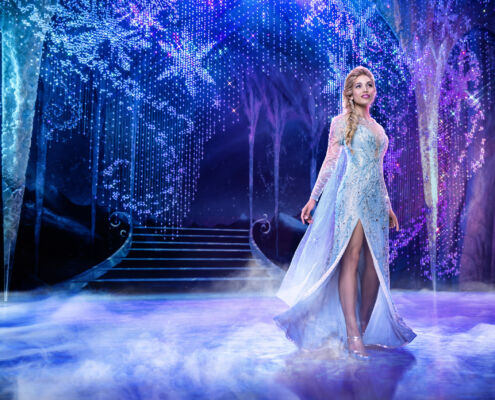“Snow Queens/Show Queens: Dragging Frozen”
Selection
Frozen on Broadway is a much queerer product, and this is not only because it retells the plot of the original film in a new medium without the addition of the plot of Frozen II but also because Michael Grandage’s directorial choices and the form of the Broadway musical itself make more queer responses available to audiences. As I hinted earlier, the musical’s more intriguing queerness is also partially related to the fact that the audience for Frozen: the Broadway Musical is largely the same as the audience for Saturday Night Live – adults. Their attitudes toward and ideas about Frozen’s characters are quite different than those of the majority audience for the films.
The plot of the musical is nearly identical to the first movie, with a few key alterations. Olaf’s construction by the two girls takes a good deal more time in the show, and little Anna and Elsa sing a new song, “A Little Bit of You,” while they build him. Onstage, the trolls from the film are transformed into “the hidden folk of the mountain,” although they come to help the royal family just as the trolls would. Pabbie and the other trolls trade in their smooth, round, stone-shapes for long hairy tails, dreadlocks, and washboard abs (the trolls’ real muscles are on display in their scenes; no bodystockings for these rock-hard abs). Functionally, these are the trolls, but this way the characters become much more humanoid, and this change obviates the need for giant puppets or cartoony bodysuits like the ones we might see at Disneyland.
All of the songs from the film make appearances on Broadway: Anna sings “Do You Want to Build a Snowman?,” “For the First Time in Forever,” and (with Hans) “Love Is an Open Door”; Olaf sings “In Summer” (garnering an enormous response in the theatre); Kristoff sings “Reindeer(s) Are Better Than People”; Grand Pabbie and his chorus sing “Fixer Upper”; and, of course, Elsa belts out “Let It Go.” But Frozen: the Broadway Musical is no mere jukebox show stringing together the movie’s songs with a plot. A Broadway musical demands many more songs than an animated feature. Generally, a Disney animated movie musical doesn’t introduce any new songs in the final third of the film, but Broadway musicals reliably jump from number to number, and audiences begin to tune out if a show spends too much time in a book scene without someone breaking into song. This has important consequences for audiences and our relationships with the characters. As Scott McMillin has argued, the effect of a song in a musical “is not so much to advance characterization as to double characterization, by turning [characters] into new versions of themselves. Their book versions are one thing, but their musical versions enlarge them into lyrical power. They are said to be the same characters, but clearly they are different, and the incongruity is theatrically arresting.” The additional songs, in other words, have the ability to enlarge and shift the characters who sing them, making them accessible to us in new ways. This is notable for Kristoff, Oaken, and Hans, who sang so little (or not at all) in the film, but it is especially important for Elsa, who is given two new songs and whose character is thereby considerably deepened.
Structurally, the position of “Let It Go” is replaced on Broadway by a new song, “Dangerous to Dream.” (Obviously, “Let It Go” belongs in the show’s climactic position, and so it needed to be moved to the end of act one.) Elsa’s new song doubles down on the imagery of solitude with which we are so familiar from the films; “Dangerous to Dream” is filled with walls closing, pulling inside, and putting up guards. But this Elsa is aware of the hiding she’s doing, and we see her attempt to connect with her sister. She sings “Dangerous to Dream” to Anna, who does not hear her. “I wish I could tell the truth / Show you who’s behind the door,” she tells her sister. “I wish you knew what all this / Pantomime and pageantry was for.” In the theatre these feelings are expressed explicitly, and so the audience has access to a very different Elsa than the one in the film. This Elsa sings about more than hiding or repressing. “Dangerous to Dream” articulates a series of desires, even more than the wishes I’ve mentioned already. Elsa sings, I “wish / I could make choices of my own,” and she laments to an unhearing Anna that “I can’t show you / I’m not as cold as I seem.” This song offers the audience an insight into the feelings of the character that we cannot see either in the book or in “Let It Go.” If the central metaphor for Elsa and Anna’s relationship – the closed door – is still at work in “Dangerous to Dream,” the difference this song gives us is Elsa’s desire to “open up that door / And finally see you face to face.” Even more, we are able to glimpse not only the possibility of freedom and openness that Elsa articulates but also her emotional response to that freedom. Elsa tells us at the end of the song that she “can’t stop smiling,” and she says to Anna that she “would love to know you.” We see, just briefly, within the lyric time of “Dangerous to Dream,” an uncloseted Elsa, one who knows she made her parents proud and wants to get to know her sister. We must return to book time, of course, and Elsa opposes Anna and Hans’s engagement, frightens all of the courtiers, and then flees into the mountains.
“Let It Go” on Broadway is a fabulous number, even if it is, in many ways, identical to the film’s version of this song. It is, in fact, lyrically indistinguishable, but the Broadway show’s stage technologies make this “Let It Go” something special. The number’s high point is a satisfying dress reveal that arrives after the bridge at exactly the perfect moment. In the film, Elsa builds her new dress over the course of two repetitions of “let it go” and the phrase “I’ll rise like the break of dawn.” Onstage, the change happens in one satisfyingly spectacular instant. It’s a stunning onstage quick-change that happens so fast that it – unlike the construction of Elsa’s ice castle and the snow flurries that issue from her hands – actually looks like magic. The gown Elsa now wears is covered in crystals and stones, and the fact that the drag queens on Drag Race season 12 were asked to riff on this look reminds us that this aspect of Frozen belongs to the context of drag performance. Elsa’s gown – at least on stage – was modeled on gowns from the world of drag pageantry. Further, Elsa’s onstage quick-change resembles nothing so much as the talent portion of a pageant competition like Miss Gay USofA, Miss Continental, or Entertainer of the Year. Dress-reveals like Elsa’s have been part of drag acts like those of Aurora Sexton, Asia O’Hara, and Nina West for years and were brought to mainstream viewers most notably by Violet Chachki on Drag Race season 7 (2015). Caissie Levy’s vocal performance of “Let It Go” reaches higher and does so more easily than Idina Menzel’s version in the film, but in many ways “Let It Go” on Broadway gets a standing ovation for its drag-pageant combination of gown/talent.
Elsa’s big song in act two is called “Monster,” and its approach to the snow queen is totally different from the essentialist versions of Elsa in the original film and its sequel. In this song, Elsa describes for us how others read her. She recognizes that it is the perceptions of others that label her as monstrous, and rather than singing about shutting doors and closing walls, she wonders if she is trapped “in a cage” that is not of her own making. The shift of this song is fundamentally about Elsa’s own agency, and her powers here are not contrasted with heterosexuality so much as they are contrasted with hostility and normativity. “Is the thing they see / The thing I have to be?” she asks. What is fascinating about “Monster” is that although it returns us to the familiar question of What Elsa Is, it shifts the perspective so that Elsa herself begins to ask not who she is but if she is what other people say she is, and even more importantly than that, to ask who she wants to be: “I cannot be a monster,” she sings to herself, “I will not be a monster / Not tonight.” It is a song in which the snow queen refuses others’ labels for her and charts her own way into the future. “Monster” is an enormous departure from the film’s Elsa; we know next to nothing of her thought process in the film’s version of this part of the story. Broadway’s Elsa recognizes the labels she has been given by others, and she refuses them.



